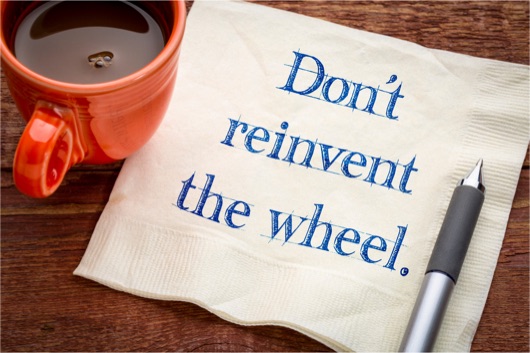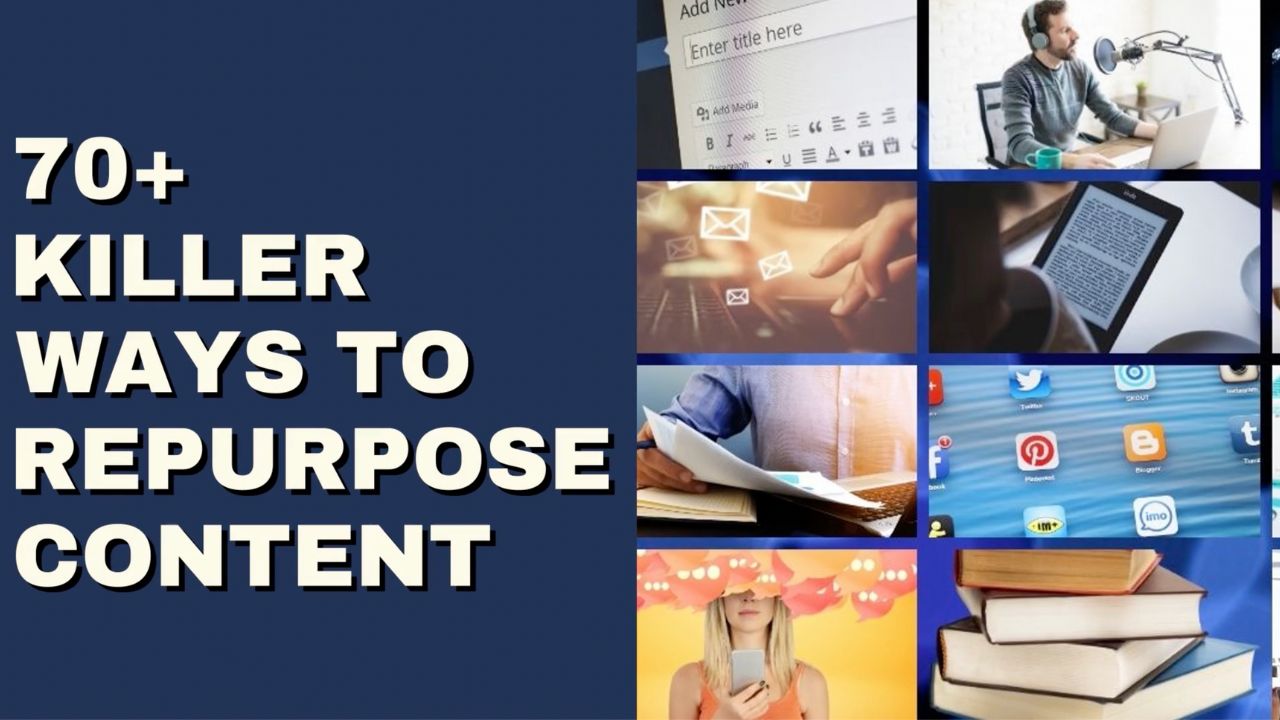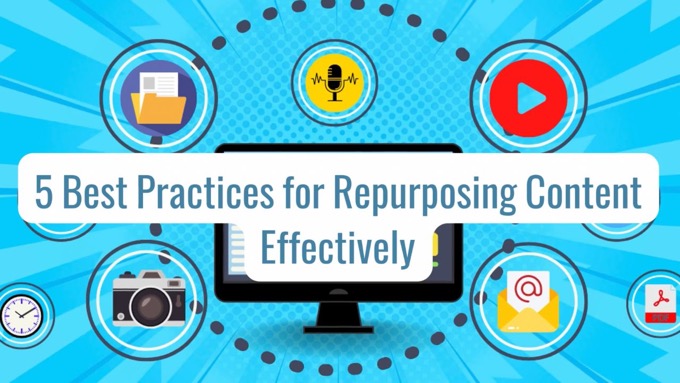What if I told you that the standard content repurposing workflow you see elsewhere is just plain wrong?
(Don't worry, I'll tell you why! And once you see it, you'll probably agree—it's kind of obvious...)
Unfortunately, most places:
- Just copy what they see recommended elsewhere, and regurgitate it
- Probably have little if any experience of actually putting it into practice.
So what should you do instead to ensure meaningful, long-term results?
This post:
- Looks at what the standard content repurposing workflow recommends... and tells you exactly what's wrong with it
- Tells you what you should do instead and why, including 7 key principles for the ultimate content repurposing workflow
Let's dive straight in and get started…
What’s Wrong With the 'Standard' Content Repurposing Workflow?
Here's what's usually recommended:
- Look for your best performing or most popular content, such as a recent blog post or video…
- Repurpose it into different formats, for example:
- Create short social media posts using snippets from the original
- Repurpose a blog post into a video or podcast episode
- Create a slideshow from the content
- And so on…
- Publish the repurposed content
- Promote it as much as you can
So what's the problem?
First, the workflow referred to above is by its very nature sporadic.
In other words, every now and again, you’re supposed to:
- Look for your best-performing content
- Repurpose it into new content you can post in lots of different places.
And of course, that’s presuming that…
- You have the time and motivation
- You’re not already hard-pressed enough to come up with the next original piece of content to publish to your main content channel (like your blog or YouTube channel)
- You don’t have a million and one other things on the to-do list that may just end up taking priority.
Yes, you've guessed it...
For the vast majority of businesses smart enough to publish regular content, the repurposing side never actually happens!
But that’s not the only problem with the above approach.
Even if you do somehow manage to schedule in the time to put it into practice, it doesn’t even work? It’s largely just a waste of time.

Huh? Why doesn’t it work?...
Everyone with even a smidgeon of content marketing experience knows that to be successful in the content game, you need to be publishing it regularly and consistently.
We all know that for a blog it can take months — but more usually, years — to build up momentum and start attracting a meaningful audience.
The same goes for a YouTube channel…
And it’s the same with a podcast…
The same with the mainstream social media platforms…
But you already know all of this.
Apart from the occasional, very rare, apparently “overnight” exception, it takes perseverance, commitment and tenacity.
For those more into instant gratification, content marketing is probably not a good fit. Next bright and shiny object, please…
So how is occasionally taking a top-performing piece of content and repurposing it onto other platforms supposed to benefit you?
After all, when you publish it, you’ll likely…
- Have no audience on that platform, and…
- Get drowned out by everyone who is showing up with regularly and consistently created content.
It goes without saying that:
- An occasional blog post doesn’t make a successful blog
- An occasional video doesn’t make a successful YouTube channel
- An occasional podcast episode doesn’t make a successful podcast.
And what about so-called “splintered” content, repurposed from your original, and published on mainstream social platforms?
Sure, you might have some sort of audience on one or more of these platforms already.
But then what are you publishing on these channels the rest of the time?
Surely it would be better to have a regular supply of content that just kept coming rather than a sporadic approach to repurposing that, to be frank, likely leaves you head-scratching and struggling to know what to post to social media next?
After all, social media lives off the regularly-updated feed.
Repurposing is perfect for providing that regular content…
But being sporadic in your repurposing activities just isn’t.
On top of that, when you’re sporadically repurposing content every now and again…
You’re constantly reinventing the wheel!
When you’re repurposing content effectively, there’s an ongoing process involved. You take Content A and transform it into Content B.
Over time, you:
- Get better at it
- Correct any mistakes
- Build in efficiencies
It all gets easier and quicker.
But if you’re only doing it every now and again on a sporadic basis, you don’t get the benefit.
You’ve likely forgotten what you did the last time… so you have to start all over, again, effectively reinventing the wheel each time.
And probably repeating the same mistakes.

Can’t you just outsource it to someone who knows what they’re doing?
It sounds easier, sure.
But there’s a problem with this approach too if you’re approaching content repurposing sporadically.
For one, it usually takes a significant investment of time to find someone suitable in the first place.
It can often be your second or third hire before you find someone you know you can really deliver.
That’s going to ramp up your overall costs.
But even when you do find someone who can, for example, repurpose that successful video into a post for your blog, there’s another problem…
There’s no consistency in your relationship with them.
An effective content repurposing workflow is one that's put into action on a regular and consistent basis. You've got to keep showing up.Click To Post OnIf it’s a one-off, occasional job, they don’t get to:
- Learn your likes and dislikes
- Gain a deeper understanding of what you’re looking for that develops over time.
So it takes more of your time trying to guide them, such as going back and forth with revision requests.
And most of the time, you end up with a poorer result than could be achieved with a change in approach.
(For example, there are none of the time efficiencies and output improvements you get when you regularly and consistently work with a set person, and where you can effectively, after an initial period, “leave them to it").
And what happens when you decide to take up the repurposing mantle again at some point in the future?
You approach them to ask them to help you again, only to find that they’ve moved on.
Or maybe they're simply prioritizing more valuable clients who give them more regular work and with whom they’ve built stronger relationships.
So yes… even outsourcing works far better when you’re approaching it in a regular, consistent way.
So What Should Your Content Repurposing Workflow Look Like?
I’m sure you’ve got the most important point already.
To be effective, your content repurposing workflow needs to be a process that’s put into action on a regular and consistent basis.
In other words, presuming you’re regularly publishing content on a channel like a blog or a YouTube channel, the workflow should swing into action every time you publish.
But isn’t it only worth repurposing your “best performing” content?
Here’s the problem.
It may have been “best performing” on your current main content channel.
But that’s no guarantee it’s going to do just as well somewhere else.
It happened to do well in a particular format on a particular channel, but some of that might well be down to factors outside your control.
(As just one example, maybe an influencer spotted it, shared it, and gave it a lift).
There’s no particular reason why it’s going to perform just as well when it’s republished in a different format to a different audience somewhere else!
And what about the rest of your content?
If you only repurpose your best performing content, by definition you’re ignoring all your other content (which by the way are all content assets with a whole stack of yet-to-be-realized value locked up inside).
And the truth is, you just can’t tell how your content is going to perform when you publish it on a different channel in a different format.
Completely different variables are at play.
Past performance is no guide to future performance when it’s repurposed and published somewhere else.
Not only that, but…
- “Performance” can change over time
- Evergreen content can far outperform flash-in-the-pan content when you consider your results over a longer time horizon.
But how will you judge “performance” anyway?..
- How many “likes” it attracted on social media last month?
- How much traffic it’s attracted to your website over the past three years?
The answer is rarely black and white.
The far more effective approach is regular, consistent repurposing…
By repurposing on a consistent basis, you unlock the true value of your content.
Here are three main reasons why it works so well…
1. You keep showing up
By consistently showing up on a platform, you grow your audience on it. Over time that starts to amplify the content you’re publishing there.
That’s how content marketing becomes so effective over time.
In contrast, sporadic repurposing is of little or no benefit.
2. You reach far more people
Just because you prefer publishing regular content on a blog, or publishing regular YouTube videos, or producing a regular podcast, doesn’t mean everyone in your marketplace wants to consume content in that format.
That would be a crazy assumption to make.
Instead, the people you’re trying to connect with—your future prospects and customers—all have different preferences for both consuming content and the platforms where they tend to hang out the most.
- Some prefer reading content…
- Some prefer watching videos…
- Some prefer listening to podcasts…
- And some rarely go anywhere but the feeds on social platforms, constantly scrolling through, looking for content of interest.
And on it goes…
That doesn’t mean your content has to be in all formats… but the more formats you regularly and consistently repurpose it into:
- The more visible you’ll be
- The more people you’ll reach
- The more authority you’ll grow
And ultimately the more successful your business will be.
It’s relatively obvious that businesses that embrace cross-platform publishing capabilities will outcompete those who don’t. They’ll simply be reaching more of the marketplace and be far more visible.
3. It’s so much more efficient
Like anything else, when you do something regularly, you get better at it.
Repurposing takes longer in the beginning, sure. It probably even feels uncomfortable.
But over time, you (either personally, or as a business) get really good at it.
And the discomfort transforms into familiarity and expertise:
- You halve the time it takes… and then probably halve it again.
- You develop a system, a process… and keep refining it as you spot potential improvements and performance lifts.
But only when you’re consistent in your approach.
In other words, make it a priority to regularly and consistently repurpose content from your main content channel into one or more other formats that can be published elsewhere.
- If you regularly publish a blog, how can you repurpose every post you publish into some kind of video and stick it on YouTube? (And then embed it back onto your blog to give your search rankings a boost).
- If your main channel is YouTube or a podcast, how can you repurpose each piece of content into a blog post? (With the original content embedded into it!)
Just start somewhere...

7 key principles for the ultimate content repurposing workflow…
The repurposing workflow you end up using for your business depends on:
- The resources you have available… or more accurately, the resources you’re willing to invest in to create the type of results you’re looking for
- Where your audience hangs out… there’s little point, for example, in consistently repurposing content for LinkedIn when your business is B2C
It will also evolve over time — it should never be set in stone.
To help you create a workflow that works well for your business, here are 7 key principles to keep in mind…
1. The most important factor is consistency…
Start small, with a repurposing activity you can keep doing on a regular basis.
Build from there.
2. Just do something…
It doesn’t have to be perfect.
In fact, no offense, but it most likely won’t be!
Just aim to improve as you go along and gradually master it.
It’s far more important to start doing something, even if it’s problematic or even disastrous at the beginning, than to endlessly procrastinate and end up doing nothing.
3. Create a written process…
When you have a written process, it stops you reinventing the wheel each time.
And as you find improvements and efficiencies you can adjust the process accordingly, effectively cementing your growing proficiency.
A written process also makes it far easier to…
4. Delegate it…
The biggest handicap small business owners and even content marketing managers have with repurposing consistently is trying to do it all themselves.
To ensure regular and consistent action, delegate it.
The biggest handicap small business owners have with repurposing content on a consistent and regular basis is trying to do it all themselves. Delegate it.Click To Post OnGive someone else the responsibility, with the written process for them to follow.
Make it a regular part of their job, and make them accountable for its completion.
Otherwise, with constant competing priorities, it simply won’t get done.
5. Add additional repurposing activities to your process…
As you develop the habit of repurposing regularly and consistently and start to experience the benefits, you’ll likely want to add additional activities into your workflow.
You’ll also find the repurposing gets quicker and easier over time too, freeing up resources to do so.
6. Leverage your repurposed content wherever possible...
Look for opportunities to leverage your repurposed content in different ways.
Some simple examples…
- Embedding a video back in the original blog post… (or embedding the original video in a blog post repurposed from it)
- A 100 - 120 word summary of a blog post used as the description for a repurposed video on YouTube, as the text for images for an Instagram carousel post, and as the basis for an X thread
- An Instagram carousel post repurposed to LinkedIn
- A TikTok video repurposed as a YouTube Short (or vice versa)
- Extracted quotes used for both quote images for social media, ‘click to post’-type links in a blog post for X, and your own posts on X of course
You get the idea…
7. Use software to help
One of the main challenges when repurposing content regularly and consistently is keeping track of everything, such as who’s doing what, and what part of the workflow you’re currently in for a particular piece of content.
This is where use of the appropriate software becomes essential for keeping everything on track and ensuring your repurposing workflow happens as efficiently as possible (otherwise, to be frank, it can become a logistical nightmare!).
- Trafficonomy was designed with just that purpose in mind, ensuring your content repurposing workflow gets taken care of without the headaches and hassles that can otherwise ensue.
Frequently Asked Questions
What's wrong with the 'standard' content repurposing workflow that most people seem to recommend?
Repurposing content sporadically is largely a waste of time; consistency is crucial for effective results.
Why doesn’t repurposing content on a more sporadic basis work?
Regular and consistent content publication builds audience and visibility, sporadic repurposing is less effective.
What's the problem with outsourcing the work involved in content repurposing when you approach it sporadically?
When approached sporadically, outsourcing the work involved in content repurposing lacks consistency, limits relationship development with the outsourced party, and makes it harder to develop expertise and proper processes.
To Conclude
As we’ve seen, the usual advice for creating a content repurposing workflow leaves a lot to be desired… mainly because sporadically repurposing content every now again is barely worth the effort!
Instead, as outlined in this post, content repurposing needs to be integrated into your existing content publishing activities so that it can be taken care of regularly and consistently.
After all, it’s only through regular and consistent publication of content that the benefits of content marketing start to stack up.
Integrate repurposing as a regular part of your content publishing activities so that it can be done consistently — for effective repurposing, consistency is key.Click To Post OnContent repurposing has to be approached the same way… and developing consistent cross-platform publishing capabilities is becoming increasingly essential (or risk becoming drowned out by competitors who already understand its importance for reaching your marketplace).
So start by creating a basic content repurposing workflow to start with, using the principles outlined above… and then improve, develop and grow it over time.
P.S. Don't forget about repurposing old content too! Here are 7 tips and tricks for taking care of that.





